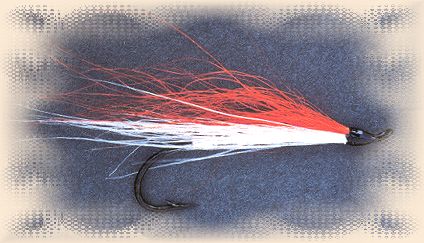Great Canadian Flies
Polar Bear Hairwings

By Arthur James Lingren
From Fly Patterns of British Columbia, Published
by Frank Amato Publications.
We appreciate use permission.
According to Roderick Haig-Brown, 1935 was a consequential year
for saltwater salmon fly fishing. Previous to 1935, fishermen
used the standard bucktails, dressed on 2/0 hooks with bucktail
wings about 2 inches long, but in 1935 they realized that longer
winged flies represented the cohoes' quarry, the needlefish. Also
in the '30s, flies of more brilliant luster dressed with the more
translucent and flexible polar bear hair replaced the dull and
brittle bucktail hair.
Tommy Brayshaw didn't fish Duncan Bay in 1935; however, he did
with his wife Becky in 1936, and recorded in his diary usuage of
polar bear hairwing flies. He writes:
"Sept 1st. Did not go out early. Took Mr. B. down to the bus at
9 then called on R. H[aig]-B[rown] & decided to go to Duncan Bay
. . .A few boats there [but] all blank, nothing doing till after
lunch when at 1.45 Becky got a cohoe 6 1/4 pounds on white & orange
polar bear. I followed with a 4 1/2 pounder . . .Becky got another
of 6 pounds . . ."
Later, in 1938, Brayshaw recorded the first that I have managed to
locate, documented-in-writing usage of polar-bear winged flies for
trout on the Adams River.
For the saltwater salmon fly fisher, the switch to polar bear hair
and longer winged flies that resulted in larger catches is undoubtedly
true, but with the longer winged, single-hook flies, fishermen started
to complain about short-taking fish.
Charlie Stroulger, long-time Duncan guide and sportfisher, in a
November 1994 letter, remembers those short-taking fish and says:
"Polar bear started to come alive in the late 1930s and early 1940s
. . .In those days we only had single hooks and the hair was too long
so the fish were taking short.
I went to a friend of mine that tied flies and asked him if he could
[put on] a trailer hook. . .He tied the trailer hook on with copper
wire and I believe this was the start of the double hooks. It really
made a difference in catching cohoes."
In the '30s as it is today, throwing with a fly rod a two-inch-long
bucktail or polar-bear hair-wing fly dressed on a 2/0 hook was
possible, but unless fish were milling fly casting to cohoes in the
ocean was a chancy proposition. When the fly length was increased
to three inches and longer and with the addition of the trailer hook,
casting was almost impossible and trolling the big flies became ever
more popular. The sport that developed around trolling flies for
coho - whether the flies were constructed of deer hair or polar bear
hair - became known as bucktailing and that name has stuck to this
day."
Details
Hook: Number 2/0 to 8.
Body: Flat silver tinsel.
Wing: Polar bear: white under followed by
Yellow, red, blue, purple, mauve, or green.
Originator: Unknown.
Intended Use: Coho salmon.
Location: Cowichan and Duncan bays.
~ Arthur James Lingren
Credits: From Fly Patterns of British Columbia
by Arthur James Lingren. We thank
Frank Amato Publications, Inc. for use permission!
Our Man In Canada Archives
|

